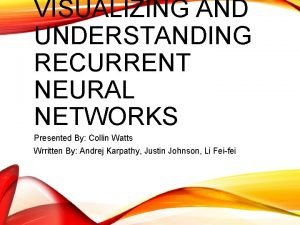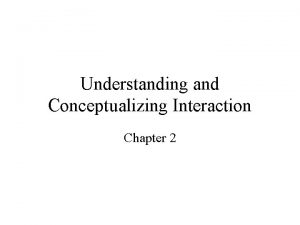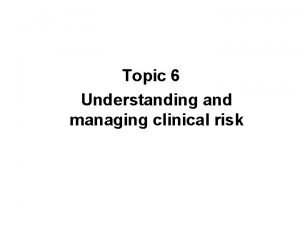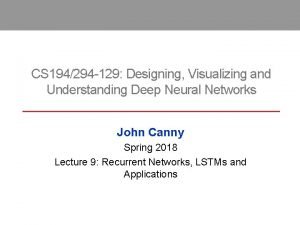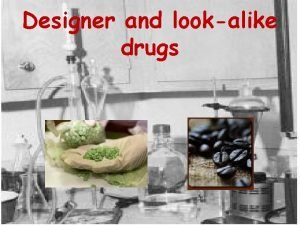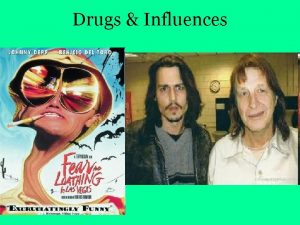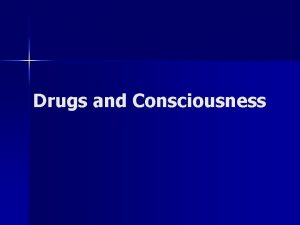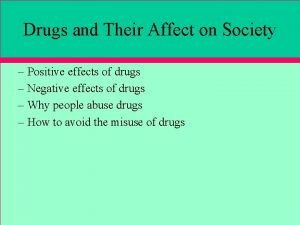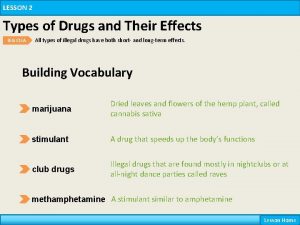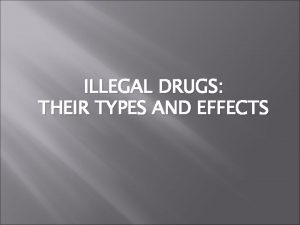Drugs Understanding drugs and their effects n n















- Slides: 15

Drugs Understanding drugs and their effects


n n n n n drug Any substance, other than food, that affects bodily functions and structures when taken into the body. drug abuse The excessive use of a drug in a manner inconsistent with accepted medical practice. drug dependence Continued substance use even when its use causes cognitive, behavioral, and physical symptoms. drug misuse The use of a drug for a purpose (or person) other than that for which it was medically intended. drug diversion The transfer of a drug from the person for whom it was prescribed to another individual. intravenous Into a vein. intramuscular Into or within a muscle. subcutaneous Under the skin. toxicity Poisonousness; the dosage level at which a drug becomes poisonous to the body, causing either temporary or permanent damage.

A drug is a chemical substance that affects the way you feel and function. n n n In some circumstances, taking a drug can help the body heal or relieve physical and mental distress. In other circumstances, taking a drug can distort reality, undermine well-being, and threaten survival. No drug is completely safe; all drugs have multiple effects that vary greatly in different people at different times. Knowing how drugs affect the brain, body, and behavior is crucial to understanding their impact and making responsible decisions about their use.

Drug abuse is the widely used term for the improper use of drugs, but some researchers have broken down the behavior into several categories: n n • Drug abuse is a pattern of substance use resulting in negative consequences or impairment. • Drug dependence is a pattern of continuing substance use despite cognitive, behavioral, and physical symptoms. • Drug misuse is taking a drug for a purpose or by a person other than that for which it was intended or not taking the recommended doses. • Drug diversion is the transfer of a medication from the individual to whom it was prescribed to another person.

n n n Risks are involved with all forms of drug use. Even medications that help cure illnesses or soothe symptoms have side effects and can be misused. Some substances that millions of people use every day, such as caffeine, pose some health risks. Others— like the most commonly used drugs in our society, alcohol and tobacco—can lead to potentially life threatening problems. With some illicit drugs, any form of use can be dangerous. Many factors determine the effects a drug has on an individual. These include how the drug enters the body, the dosage, the drug action, and the presence of other drugs in the body—as well as the physical and psychological makeup of the person taking the drug and the setting in which the drug is used.

Routes of Administration n n Drugs can enter the body in a number of ways The most common way of taking a drug is by swallowing a tablet, capsule, or liquid. However, drugs taken orally don’t reach the bloodstream as quickly as drugs introduced into the body by other means. A drug taken orally may not have any effect for 30 minutes or more. Drugs can enter the body through the lungs either by inhaling smoke, for example, from marijuana, or by inhaling gases, aerosol sprays, or fumes from solvents or other compounds that evaporate quickly. Young users of such inhalants, discussed later in this chapter, often soak a rag with fluid and press it over their nose. Or they may place inhalants in a plastic bag, put the bag over their nose and mouth, and take deep breaths—a practice called huffing and one that can produce serious, even fatal consequences.

Routes of Administration n Drugs can also be injected with a syringe subcutaneously (beneath the skin), intramuscularly (into muscle tissue, which is richly supplied with blood vessels), or intravenously (directly into a vein). Intravenous (IV) injection gets the drug into the bloodstream immediately (within seconds in most cases); intramuscular injection, moderately fast (within a few minutes); and

Routes of Administration n n subcutaneous injection, more slowly (within ten minutes). Injecting drugs is extremely dangerous because many diseases, including hepatitis and infection with human immunodeficiency virus (HIV), can be transmitted by sharing contaminated needles. Injection drug users who are HIV-positive are a major source of transmission of HIV among heterosexuals.

Dosage and Toxicity n n n The effects of any drug depend on the amount an individual takes. Increasing the dose usually intensifies the effects produced by smaller doses. Also, the kind of effect may change at different dose levels. For example, low doses of barbiturates may relieve anxiety, while higher doses can induce sleep, loss of sensation, even coma and death. The dosage level at which a drug becomes poisonous to the body, causing either temporary or permanent damage, is called its toxicity. In most cases, drugs are eventually broken down in the liver by special body chemicals called detoxification enzymes.

YOUR STRATEGIES FOR PREVENTION n n n How to Say No to Drugs If people off er you a drug, here are some ways to say no. • Let them know you’re not interested. Change the subject. If the pressure seems threatening, just walk away. • Have something else to do: “No, I’m going for a walk now. ” • Be prepared for different types of pressure. If your friends tease you, tease them back. • Keep it simple. “No, thanks, ” “No, ” or “No way” all get the point across. • Hang out with people who won’t offer you drugs.



Interaction with Other Drugs or Alcohol n • • A drug can interact with other drugs in four different ways: An additive interaction is one in which the resulting effect is equal to the sum of the effects of the diff erent drugs used. A synergistic interaction is one in which the total effect of the two drugs taken together is greater than the sum of the effects the two drugs would have had if taken by themselves on separate occasions. Mixing barbiturates and alcohol, for example, has up to four times the depressant eff ect that either drug has alone. A drug can be potentiating—that is, one drug can increase the eff ect of another. Alcohol, for instance, can increase the drowsiness caused by antihistamines (antiallergy medications). Drugs can interact in an antagonistic fashion—that is, one drug can neutralize or block another drug with opposite eff ects. Tranquilizers, for example, may counter some of the nervousness and anxiety produced by cocaine.

YOUR STRATEGIES FOR PREVENTION How to Say No to Drugs If people off er you a drug, here are some ways to say no. • Let them know you’re not interested. Change the subject. If the pressure seems threatening, just walk away. • Have something else to do: “No, I’m going for a walk now. ” • Be prepared for different types of pressure. If your friends tease you, tease them back. • Keep it simple. “No, thanks, ” “No, ” or “No way” all get the point across. • Hang out with people who won’t offer you drugs. n
 Lesson 2 session 3
Lesson 2 session 3 Language features and their effects
Language features and their effects Language features and their effects
Language features and their effects Romeo & juliet prologue
Romeo & juliet prologue Causes and effects of the french and indian war
Causes and effects of the french and indian war When was remains by simon armitage written
When was remains by simon armitage written Visualizing and understanding recurrent networks
Visualizing and understanding recurrent networks Visualizing and understanding convolutional neural networks
Visualizing and understanding convolutional neural networks Sqa understanding standards
Sqa understanding standards Understanding standards higher art
Understanding standards higher art Conceptualization interaction
Conceptualization interaction Managing clinical risk
Managing clinical risk Sociology understanding and changing the social world
Sociology understanding and changing the social world Lack of understanding in relationship
Lack of understanding in relationship Essential understanding examples
Essential understanding examples Coco
Coco






